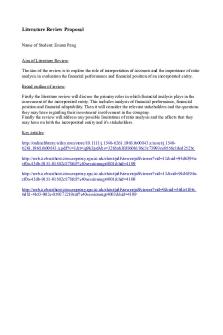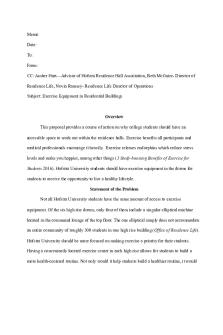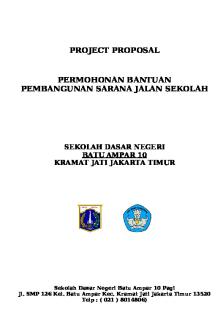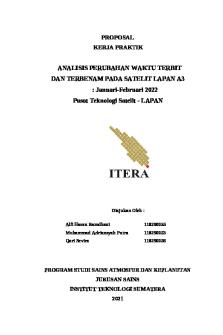Proposal PDF

| Title | Proposal |
|---|---|
| Author | Kathleen Grace Martin |
| Course | Digital Business Design and Innovation |
| Institution | Royal Melbourne Institute of Technology |
| Pages | 19 |
| File Size | 1.2 MB |
| File Type | |
| Total Downloads | 45 |
| Total Views | 172 |
Summary
business proposal...
Description
Proposal issued: 10/5/20
Proposal valid to: 2/8/20
PROPOSALF OR AUGMENTEDREALI TY PREP AREDF OR
0
T ABLEOFCONT ENT S 1 . EXECUTI VESUMMARY
1
2 . BUSI NESSI SSUE
2
3 . SOLUTI ON
3
CATWOE ANALYSIS ROOT DEFINITION OVERALL USE CASE DIAGRAM SEARCHING FOR CLOTHES SUGGESTING OUTFIT SIZES ACCORDING TO THE DRESS CHOSEN ASKING FOR ASSISTANCE CREATING AN ACCOUNT ON THE STYLE MIRROR 4 . PROJ ECTMANAGEMENT
4 4 4 5 6 7 8 9
PROJECT SCOPE CHECKLIST: WORK BREAK DOWN STRUCTURE (WBS): GANTT CHART
9 9 13
5 . COSTBENEF I TANAL YSI S
14
PAYBACK AND RETURN ON INVESTMENT ANALYSIS
15
6 . APPENDI X
16
ROLES
16
7 . REFERENCES
17
1
1 .EXECUTI VESUMMARY As we discussed, INSHOP Fashion has recently been experiencing a decline in sales and in particular want guidance on how to stand out. Reasons are outlined within this proposal. As a solution, the implementation of technology such as a virtual reality mirror (STYLE MIRROR) would best suit your store in order to stand out amongst retailers within the vicinity. Studies show that businesses that incorporate technology to enhance operational efficiency and customer experience, are likely to be the most successful (Grewal et al., 2019). STYLE MIRROR enables the customer to browse a catalogue of clothing and select the colour and category as the please. Customers will be encouraged to register as an INSHOP Fashion member in order to obtain perks. Ideally STYLE MIRROR will help to recommend outfits for consumers. Typically, retail consumers are impulse buyers, therefore most of the time they are unsure on their decision in the moment. STYLE MIRROR will significantly reduce the consumer’s burden to verbalise their needs. (Felfernig et al., 2013) Personalisation is now key to gaining the competitive advantage in retail, as it leads to high levels of loyalty and engagement (Verhoef et al., 2010). Collating a better database of your customer’s buying behaviour will help to decide what to offer at the right time (Augusto et al., 2012), inevitably catering towards your customer’s style and saving on inventory holding costs (Gustafsson and Jonsson, 2019). Orders can also be placed and paid through the mirror where it will notify staff members to prepare the clothes for collection. This proposal will also look into issues concerning the business and the process in which the solution will be implemented along with the information on what the new system is expected to provide for the business. This will cover the 14-week project, detailing significant events and milestones such as Prototype development, Prototype testing and approval, Style Mirror Instalment and intensive training Staff members in time for the launch. The STYLE MIRROR will cost the business during the early years of implementation. This is because it will take time for the business to efficiently centralise itself towards the system. Given proper training of staff and marketing tactics the technology will integrate the purchasing behaviour of customers and provide a better outcome. INSHOP Fashion will have to pay for the manufacturing of the mirror and creation of the operating system. The employees must also maintain and update software themselves. The cost benefit analysis highlights the long-term impact of the business which will reach an increase of 23.43% on return of investment after the course of 6 years increased cost is on the assumption that as the years progress, the decrease of the loan value for the material money will be significant. The introduction of the STYLE MIRROR into the business will significantly decrease workload for your employees. Automating stock will enable you to better forecast and track inventory as being inventory-light is useful to responding to changing demands in the market (Gustafsson and Jonsson, 2019). Sales staff of INSHOP will also have a peace of mind in regards to monitoring customer thefts along with the appropriate training. This device will aid in alerting the staff if customers need help finding or getting clothes as well as informing management on inventory status and will also provide accurate seasonal sales reports.
1
2 .BUSI NESSI SSUE Upon analysis of INSHOP Fashion, a number of processes were identified. In particular, areas of improvement that can be implemented using technology. We have discussed that your business has been suffering profit losses due to low sales volumes. There are numerous reasons for low sales volume such as traditional operation of the store, not many returning customers or walk-ins and most importantly the issue of theft, which relates to the inconsistent number of low stock and low profit.
( S h e r y l Gu t ma n )
INSHOP Fashion Rich Picture
The rich picture above illustrates all the activities of INSHOP and the issues that it is currently facing. It can be evaluated that the lack of proper training for theft has left staff unsure on how to handle theft. The lack of returning customers or walk-ins to the store is due to the fact that customers find the clothing satisfactory but not eyecatching. This has led surrounding boutiques to gain the competitive advantage. It is evident that INSHOP urgently needs to change your traditional approach of customer service to a technological based interaction in order to regain the competitive advantage.
2
3 .SOL UTI ON The proposed solution for your business would be a VR try on mirror (STYLE MIRROR) which will replace normal mirrors in fitting rooms. Customers will be able to browse, select designs and filter searches by clothing category and colours through the VR mirror by using the touch screen system. The purpose of this mirror is to eliminate the need for customers to try the clothes on physically. The mirror will first scan the moving full body customer to provide an accurate clothing size. A mirror image of themselves will then be shown in the chosen clothes, customers will have the ability to change with a simple tap. This will be beneficial to the customers as it enhances the try on process by allowing them to try on more clothes in a shorter amount of time, which may also help increase in sales volume. The system can also help to minimise the cases of theft and damaged clothes, hence, preventing further inconsistent data of inventory and profits.
What the STYLE MIRROR would essentially look like
Other than that, customers can sign up for a membership system which can be done through the VR mirror. Benefits such as being able to save selected outfits for future references and provide suggestions on similar clothing styles available in store. Orders can be placed and paid through the mirror where it will notify staff members to prepare the clothes for collection. Other than the ability to build a loyal customer base through this system, it can also help the business to analyse data such as the most and least popular clothing selections in order to provide products that caters more towards your customer’s style. The device will also note facial expressions of customers when trying on clothes. In addition, no other shop in the vicinity has STYLE MIRROR, this point of difference will help to increase instore foot traffic and walk-ins, thereby regaining a competitive advantage among clothing stores within the vicinity.
3
CATWOE Analysis The CATWOE analysis and root definition for your business and the new proposed system is presented down below: C
INSHOP Fashion customers
A
INSHOP Fashion employees
T
Trying on clothes virtually
W
Having a better and personalised shopping experience can help to enhance customer loyalty which will lead to an increase in sales revenue. This can also prevent clothes from getting damaged or stolen.
O
INSHOP Fashion
E
System failure/malfunction or power outage
ROOT DEFINITION A system owned by INSHOP Fashion, where it focuses on providing a better and personalised shopping experience that can help to enhance customer loyalty which will lead to an increase in sale revenue as well as to help prevent clothes from getting damaged or stolen by allowing customers to try on clothes virtually given that the constraints where a system failure/malfunction or power outage in store may occur.
OVERALL USE CASE DIAGRAM Below the overall use case diagram shows the activities between the users who are the customers and employees, and VR mirror system.
INSHOP Fashion Use Case Diagram
4
In addition, below Expanded Use Case Diagrams are presented to detail the step by step interactions between the user and the system to achieve the predetermined task: Use Case Name
Searching for clothes
Scenario
The Customer has something in mind and would like to try it on.
Triggering event
The system notifies the stock keeper to update availability of the outfit
Brief Description Actors
The customer looks through the catalogue, chooses the clothing category and or colour, chooses fitting option, the mirror scans their body 360 degrees and displays the clothes on the customers. Customer
Related use Cases
Suggesting outfit size, Placing an order
Stakeholders
Employees
Preconditions
User must have something in the search or filter for something to show up
Postconditions
None
Flow of Activities
User
System 1. System displays home menu
2. User select log in, sign up, or to use without an account 3. System display log in/sign up page 4. System displays INSHOP Fashion catalogue, suggestions, and saved items 5. User input searches using search function 6. System displays searches 7. User select filter function 8. System displays colour, size, and category filter 9. User fill in the filters 10. System displays filtered outfits 11. User click on outfits 12. Systems shows sizes available 13. User tries on outfits Alternative Cause of Actions:
5
Line 2: User will proceed to Line 4 if they choose to try on without an account Line 6: If no results were found, return to Line 3 Line 9: If no results were found, return to Line 3 Line 12: Display ‘0’ if product is out of stock
Use case name
Suggesting outfit sizes according to the dress chosen
Scenario
Suggesting an outfit size to the customer according to the chosen outfit.
Triggering event
Customers informs the staff to bring the selected size of the selected style.
Brief Description
When the customer selects the design, the system suggests the estimated size according to their body measurements.
Actors
Customers of INSHOP Fashion.
Related Use Cases
Includes: Save size for the preference. Includes: Select size to buy.
Stakeholders
Stock keeper: to check the availability of the selected size. Staff: to bring out the size from the stockroom when customer asks for it.
Preconditions
The outfit design and colour must be selected before going on to the size. The outfit size must exist in the stock room.
Postconditions
The order must be made of the recommended size.
Flow of activities
User
System
1. Customers enter the store and use the STYLE MIRROR. 2. Home screen appears with log in option or sign up, or to use without an account. 3. User enters their details.
4. Selects to buy from the suggested styles. 5. Display all the styles with the available colour. 6. Chooses a colour in a particular style. 7. Takes the user measurement virtually and finalizes the size. 8. System saves the size for that user. Alternative Cause of Actions
6
Line 3: If the user details are not found, go to line 2 and asks user to register. Line 4: If not from the suggestions, user can select the styles from the menu using filters. Line 5: System informs if something is out of stock
Use Case Name
Asking for assistance
Scenario
The customer requests help in regard to the STYLE MIRROR.
Triggering event
The customer notifies staff for help.
Brief Description Actors
When the customer highlights the ‘help’ option, the system notifies staff that the customer requires a specific type of assistance. The customers of INSHOP Fashion
Related Use Cases
Analyse data
Stakeholders
Staff that are assigned to help customers
Preconditions
Customer is needed to perform task
Postconditions
Assigned employees must go to the customer asking for assistance.
Flow of Activities
User
System
1. Customer taps screen to activate mirror. 2. Home screen appears. 3. Customer presses ‘help’ option. 4. Input what they need help with by selecting category or type into box if other 5. Customer presses send request. 6. Sends assistance notification to specific employee
7. Displays message: ‘Help is on the way!’ 8. Employee accepts request to notify system. 9. System logs time and type of assistance needed to database for future performance reports. 10. Employee assists customer. Alternative Cause of Actions
7
Line 5: If the customer changes their mind, the customer can select cancel, the following message will pop up: ‘are you sure you want to cancel the help request? - If ‘Yes’, return to line 3. - If ‘No’ the request continues to be sent to an employee.
Use Case Name Scenario Triggering event Brief Description
Creating an account on the STYLE MIRROR User has come into the store, wanting to create an account, so that their previous outfits are saved Customer presses sign up
Actors
Customers will benefit from creating an INSHOP Fashion account in order to save their chosen styles and later visit them when trying on clothes. Previous purchases can also be brought up to see if it will match what they want to purchase now. The customers of INSHOP Fashion
Related Use Cases
Try on outfit.
Stakeholders
Customers of INSHOP Fashion
Preconditions
User must be standing in front of mirror and mirror must be turned on
Postconditions
The customer must remember account details to access account again.
Flow of Activities
User
System
1. User navigates to home menu 2. System displays available home menu 3. User selects sign up 4. System shows enter account information page 5. User fills out information form and submits. 6. System posts data to database 7. System sends confirmation email 8. User confirms email 11. User verifies it worked by signing in 12. System shows the account logged in page 13. User continues shopping 14. Exit Alternative Cause of Actions
8
Line 5: User can sign up using their Google or Yahoo account. Line 6: Unable to create account as one already exists with same details, go to line 5. Line 9: User finishes without signing into new account, terminate use case.
4 .PROJ ECTMANAGEMENT PROJECT SCOPE CHECKLIST: Below the major deliverables of the project are detailed which include key milestones, technical requirements and limits and exclusions. Objectives
To produce a multi-functional smart mirror within budget of $100,000 within 14 weeks. Smart VR mirror (STYLE MIRROR) with built in shopping. Design approved Prototype developed Prototype tested and approved Style Mirror Installed Staff members trained
Deliverables Milestones
Technical requirements
Safe long-term screen running temperatures, power efficiency, bug free software, security/privacy system to prevent payment information being accessed. INSHOP Fashion employees must maintain and update software themselves, the device will be solely built to meet the needs and requirements of the INSHOP Fashion business and customers.
Limits and exclusions
WORK BREAK DOWN STRUCTURE (WBS): This WBS outlines what is expected during the 14-week project. Variables such as the task’s start and end date, duration, cost and person responsible for performing the tasks are specified below. Code
Task
Start
Duration
End
Hours
Person Responsible
Cost
(Days) 1
Business case
10/5/20
14
24/5/20
40
The Group
$4000
1.1
Choose idea to be developed
10/5/20
5
15/5/20
10
The Group
$1600
1.1.1
Meeting to discuss client’s requirements and needs
10/5/20
1
11/5/20
2
Ishita
$800
9
1.1.2
Collect and build information documents
11/5/20
4
15/5/20
8
Nicole
$800
1.2
Assess information obtained
14/5/20
9
23/5/20
12
Kathleen
$800
1.2.1
Review documents
21/5/20
3
24/5/20
18
Ishita
$1800
2
Architecture design
24/5/20
10
3/6/20
30
Vincent
$3000
2.1
Identify design requirements
24/5/20
4
28/6/20
20
Nicole
$2000
2.1.1
Generate base design document
24/5/20
4
28-/5/2 0
20
Kathleen
$2000
2.2
Review documents
28/5/20
1
29/5/20
8
Ishita
$800
2.2.1
Meeting with client to discuss/review final designs
28/5/20
1
29-/5/2 0
8
Ishita
$800
2.3
Produce base architectural prototype
29/5/20
8
4/6/20
12
Vincent
$1200
3
User interfaces
4/6/20
14
18/6/20
40
Ishita
$4000
3.1
Identify data capture needs
4/6/20
4
8/6/20
10
Nicole
$1000
3.1.1
Implement UI features accordingly
4/6/20
4
8/6/20
10
Vincent
$1000
3.2
User desirability and UX
8/6/20
8
16/6/20
20
Nicole
$2000
3.2.1
Generate mock-ups of UI
12/6/20
4
16/6/20
10
Nicole
$1000
3.3
User interface security
16/6/20
2
1...
Similar Free PDFs

Proposal
- 1 Pages

Proposal
- 5 Pages

Proposal
- 19 Pages

Proposal bisnis
- 7 Pages

Proposal Skripsi
- 39 Pages

Proposal magang
- 26 Pages

Proposal Batik.docx
- 6 Pages

Proposal sekolah
- 8 Pages

Proposal kewirausahaan
- 1 Pages

Proposal baru
- 17 Pages

PROPOSAL magang.docx
- 5 Pages

PROPOSAL PENYULUHAN.docx
- 1 Pages

Proposal krenova
- 15 Pages
Popular Institutions
- Tinajero National High School - Annex
- Politeknik Caltex Riau
- Yokohama City University
- SGT University
- University of Al-Qadisiyah
- Divine Word College of Vigan
- Techniek College Rotterdam
- Universidade de Santiago
- Universiti Teknologi MARA Cawangan Johor Kampus Pasir Gudang
- Poltekkes Kemenkes Yogyakarta
- Baguio City National High School
- Colegio san marcos
- preparatoria uno
- Centro de Bachillerato Tecnológico Industrial y de Servicios No. 107
- Dalian Maritime University
- Quang Trung Secondary School
- Colegio Tecnológico en Informática
- Corporación Regional de Educación Superior
- Grupo CEDVA
- Dar Al Uloom University
- Centro de Estudios Preuniversitarios de la Universidad Nacional de Ingeniería
- 上智大学
- Aakash International School, Nuna Majara
- San Felipe Neri Catholic School
- Kang Chiao International School - New Taipei City
- Misamis Occidental National High School
- Institución Educativa Escuela Normal Juan Ladrilleros
- Kolehiyo ng Pantukan
- Batanes State College
- Instituto Continental
- Sekolah Menengah Kejuruan Kesehatan Kaltara (Tarakan)
- Colegio de La Inmaculada Concepcion - Cebu


